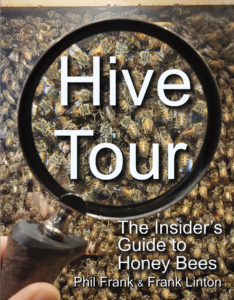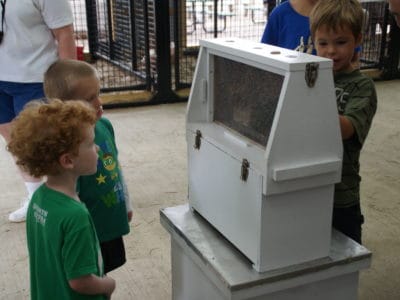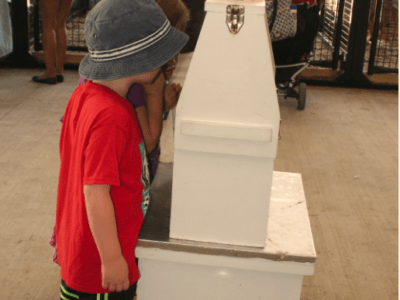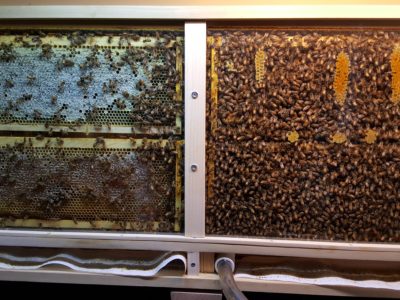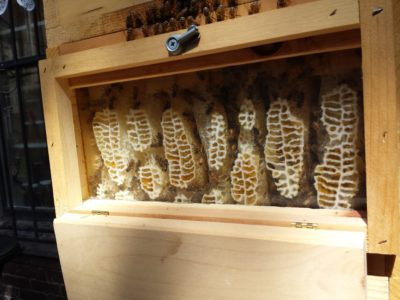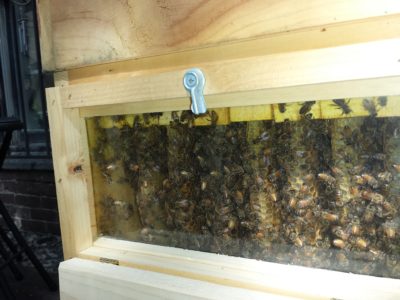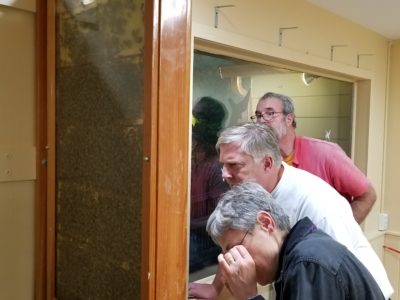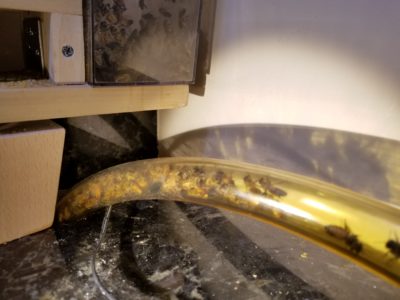Observation hives are valuable educational tools for two very different audiences, beekeepers and the public.
Observation Hives for Beekeepers
For beekeepers, especially backyard beekeepers, installing an observation hive permanently in one’s home, or seasonally on a deck or in a garage, is a way to observe all the behaviors bees engage in without disturbing the bees in ones’ production hives. Moreover, it is a way to see the seasonal changes in colony activity during spring build-up, summer nectar flows and dearths, fall cooldown, and winter cold.
As beekeeper and writer Michael Bush puts it “Every beekeeper should have an observation hive. Not only for what you will learn about bees, but what you can tell, day to day, about what is happening in your other hives”.
RESOURCES for Beekeepers wanting to start an Observation Hive: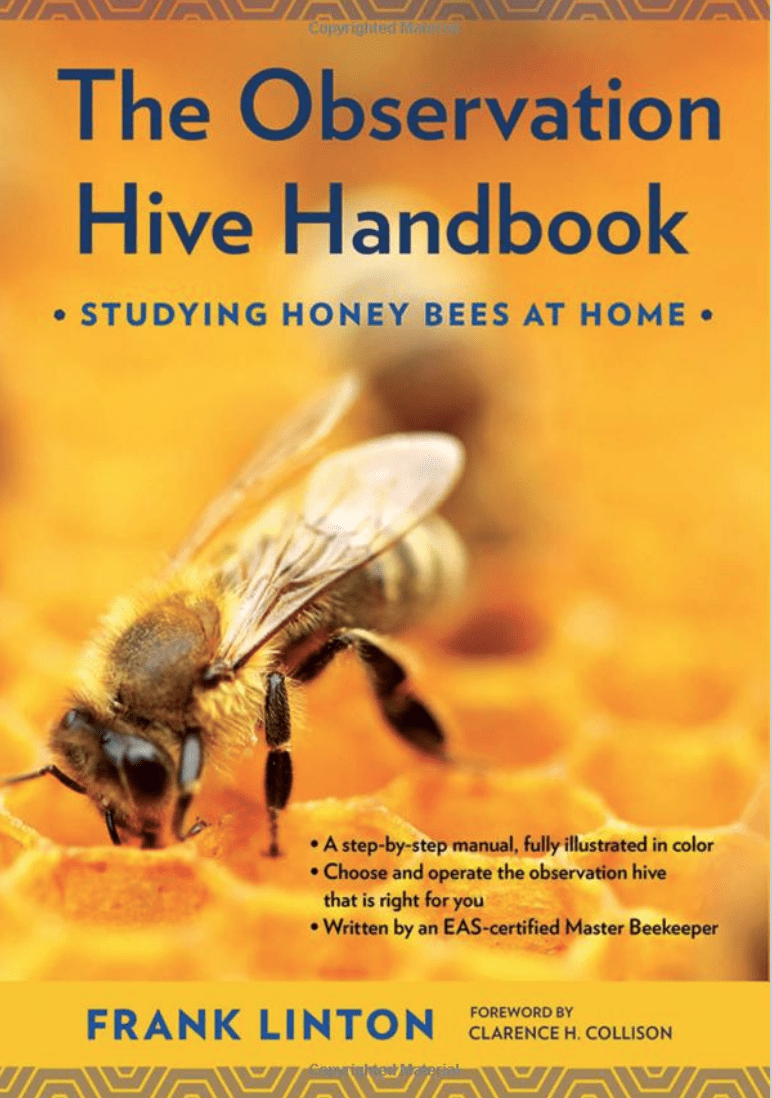
- A web page focused on observation hives for beekeepers is: http://thebeepeeker.com
- The Observation Hive Handbook is available in the MCBA library, from several beekeeping suppliers, and online bookstores such as Amazon.com (Click to see on Amazon)
We thank MCBA member and EAS-certified Master Beekeeper, Dr. Frank Linton, and Phil Frank for these resources.
MCBA members with observation hives at home include Phil Frank, Tim McMahon, Frank Linton, Jim Frazier and others [If you run an observation hive, please let us know; we’ll add you to the list.]
If you want to learn more about bees without becoming a beekeeper, check out the book "Hive Tour". It is packed with full page photos and fun facts about bees and their busy, strange lives. For a look inside the book, click HERE.
Observation Hives for the Public
Two kinds of observation hives are used for public education, temporary portable hives, and permanently fixed hives.
Beekeepers take temporary portable observation hives to farmers markets, street fairs, school visits, and the like. These are typically single-frame hives, with or without the queen. The bees and comb in these hives are often pulled from a production hive and returned to it on the same day.
These hives are used to “show and tell” about honey bees, beekeeping, pollinators, environmental issues, etc., and to attract attention to the table or booth where the hive is located.
Several temporary portable observation hive are available to MCBA members for their use in public outreach, along with a variety of informative materials. To borrow a portable observation hive contact the MCBA Outreach Coordinator. IF YOU WOULD LIKE A BEEKEEPER TO DEMONSTRATE AN OBSERVATION HIVE at your school or group, click here.
In contrast, permanently fixed observation hives are found in nature centers, museums, and other public educational sites. These hives require more attention than a standard hive because the colony must be kept healthy and appealing. Also, to be successful, a permanent public observation hive requires the coordinated efforts of a team comprised of several roles, only one of which is the beekeeper. For example:
- Someone to check the hive daily, feed it as needed, and notify the beekeeper when further attention is necessary.
- Someone knowledgeable to respond to visitor’s questions
- A docent to provide ‘tours’ or demos of the observation hive
- An exhibit designer/builder. At least a dozen themed exhibits could be built around an observation hive.
Observation hives for the public may be found in the following places in or near Montgomery County, MD:
- Croydon Creek Nature Center, Rockville: Beekeeper: Scott
- Rock Creek Park Nature Center & Planetarium, Washington, DC 20015. Beekeeper: Tony Linforth
- Orkin Insect Zoo, Smithsonian National Museum of Natural History, Washington DC.
- Maryland Honey Company, 6910 Damascus Road, Gaithersburg, MD: Beekeeper MCBA member Jim Fraser
- Others? Please let us know by clicking HERE.
Windows in Full-Size Hives
Some full-sized hives such as Flow Hives, Slovenian AZ hives, and top bar hives come with windows in their ends or sides.
These viewing ports make it possible to see a bit of what’s going on inside the hive and the advantage of a full-size hive is that the bees in it are a full-size colony.
One issue is the need to travel to the apiary to observe the bees’ behaviors, but the more significant issue is that with a window in a full-size hive, you get to see only the ends of the comb or the comb at the side of the hive. These viewing ports are better for a status check than they are for viewing bee or colony behaviors.
Things You Might See in An Observation Hive
Queen Laying Eggs
Phil Frank: When I inspect my outdoor 'regular' hives, the only queen behavior I see is her running to hide from me. When watching the colony in my kitchen, I get to see the process of egg laying. First the queen stands over an empty cell, then pokes her head deep inside. Sometimes she will then move on to the next cell without laying an egg. Sometimes she will curves her abdomen in a sharp arch, then lowers its tip deep into the cell. I never realized how long it takes her to deposit an egg. I've seen it take a full minute before she pulls her abdomen back out. Then she walks to a nearby cell can starts again.
The other queen 'activity' I often see is resting. She seems to have a couple spots she favors-- either the top right corner of the frame (most often) or the top left corner. While she's resting one or two attendants groom her, and sometimes they'll drum on her with their antennae.
Preparing to Swarm
Phil Frank: I was upstairs when my wife called up "your bees are going crazy". When I got there the noise was incredibly loud and the bees were literally running in circles around the edges of the frames. They'd s switch between running clockwise to counter clockwise, to (seemingly) running in random directions. Every worker was in constant motion, but drones were holding tight onto the cells. Frantic workers were knocking into them and buffeting them about. Then suddenly, all the workers tried to exit through the 1/2 inch entrance/exit tube. It was jammed with layers of bees all pushing toward the exit. A minute later virtually all the bees were gone, and the room was silent. Outside, there was a small tornado of bees circling toward the sky, and I assumed, out of my life. 10 minutes later, about half of the bees were back inside the observation hive, peacefully standing on the comb. Outside, the other half of the bees, the bees that were in swarm mode, had gathered on my wall, barely a foot from the tube's entrance. I scooped them into a paper lawn bag and put them into fresh, outdoor hive, where they stayed and made a new home. One big surprise for me was that I never saw the queen cells before the swarm. The workers stayed clustered around them so tightly that they were hidden.
Queen Mating Flight Departure
Frank Linton: One of the more interesting events I have seen in my observation hive is a queen mating flight. In the one I saw, the preparation and departure for mating was much like that for an orientation flight or a swarm. That is, the workers ran around inside the hive to warm up, creating a general ruckus, and raising their temperatures. Then, many workers departed in a rush. I didn’t see the queen go, but she was not in the hive with the remaining workers. After a few minutes, the workers started returning. Instead of going straight into the hive, many of them paused at the entrance and scented with their Nasanov glands. Eventually, everyone came back inside the hive and quieted down. I looked at the queen for mating sign but was not lucky enough to see any. The entire process was repeated a few times before the queen started laying.

